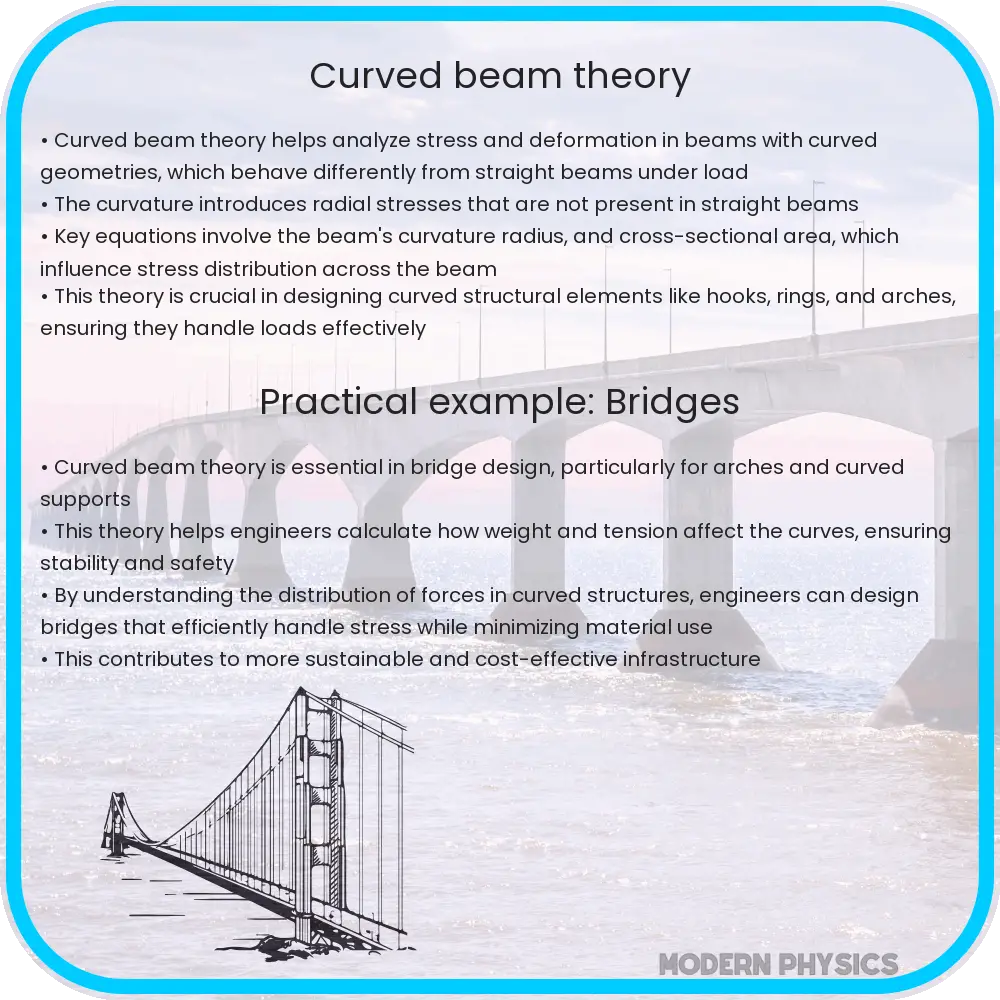Explore curved beam theory in structural engineering, focusing on stress analysis, design considerations, and advanced computational methods.

Understanding Curved Beam Theory: Fundamentals of Stress Analysis
Curved beam theory is an essential aspect of structural engineering, dealing with the stress and strain in beams that are curved in their undeformed configuration. Unlike straight beams, curved beams experience complex stress distributions due to their geometry. This article delves into the fundamentals of curved beam stress analysis and its implications in structural design.
The Nature of Stress in Curved Beams
When a curved beam is subjected to loading, it experiences not only the typical bending stresses but also additional stresses due to its curvature. These stresses are primarily divided into radial and tangential components. The radial stress (σr) occurs perpendicular to the cross-section, while the tangential stress (σθ) acts along the circumference of the beam.
Key Concepts in Curved Beam Analysis
To accurately analyze curved beams, several key concepts must be considered:
- Neutral Axis: Unlike straight beams, the neutral axis in a curved beam does not coincide with the centroidal axis. This shift significantly impacts the stress distribution across the beam’s cross-section.
- Section Modulus: The section modulus (Z) of a curved beam differs from that of a straight beam. It is crucial in determining the bending stress and is calculated considering the beam’s curvature.
- Maximum Stress Formula: The maximum stress in a curved beam is given by the formula σmax = M/Z + P/A + M*y/Re, where M is the moment, Z is the section modulus, P is the axial load, A is the cross-sectional area, y is the distance from the neutral axis, and Re is the effective radius.
Applications in Structural Design
Understanding the stress distribution in curved beams is vital for several engineering applications, including:
- Architectural structures like arches and domed roofs.
- Components in mechanical systems such as hooks and crane arms.
- Bridge design, especially in arch and suspension bridges.
The design and analysis of curved beams require a nuanced approach that accounts for their unique stress distribution. By integrating these principles into structural design, engineers can ensure the safety and reliability of curved beam structures.
Advanced Considerations in Curved Beam Analysis
For a comprehensive understanding of curved beam behavior, advanced factors must be considered:
- Stress Concentration: Curved beams often exhibit stress concentrations at points where the radius of curvature changes. This needs careful consideration in design to prevent failure.
- Material Properties: The material’s elastic modulus (E) and yield strength play a critical role in how the beam behaves under stress. Different materials will react differently to the same loading conditions.
- Load Type and Duration: The nature of the load (static or dynamic) and its duration significantly affect the stress response of curved beams. Dynamic loads, for example, can introduce fatigue stresses that need to be assessed.
Computational Methods in Curved Beam Analysis
Modern structural analysis often employs computational methods to assess curved beam behavior accurately:
- Finite Element Analysis (FEA): FEA is a powerful tool for analyzing complex structures, including curved beams. It helps in visualizing stress distribution and identifying potential failure points.
- Software Simulations: Various software packages allow engineers to model curved beams under different loading conditions, providing valuable insights for design and safety evaluations.
Design Considerations for Curved Beams
In the design phase, engineers must consider:
- Safety Factors: Due to the complexities involved, curved beams often require higher safety factors than straight beams.
- Manufacturing Constraints: The curvature of the beam may impose limitations on manufacturing processes, influencing the choice of materials and construction methods.
- Inspection and Maintenance: Regular inspections are crucial for structures utilizing curved beams, as stress concentrations can lead to fatigue and eventual failure over time.
Conclusion
Curved beam theory plays a pivotal role in the field of structural engineering, particularly in the design and analysis of architectural and mechanical structures. The complex stress distribution in curved beams necessitates a deep understanding of various factors like material properties, load characteristics, and advanced computational methods. Engineers must integrate these insights into their designs to ensure the safety, functionality, and longevity of structures that incorporate curved beams. As technology advances, the precision in analyzing and designing curved beams continues to evolve, leading to safer and more innovative structural solutions.
